Hole in the Clouds
Apr 29, 2011
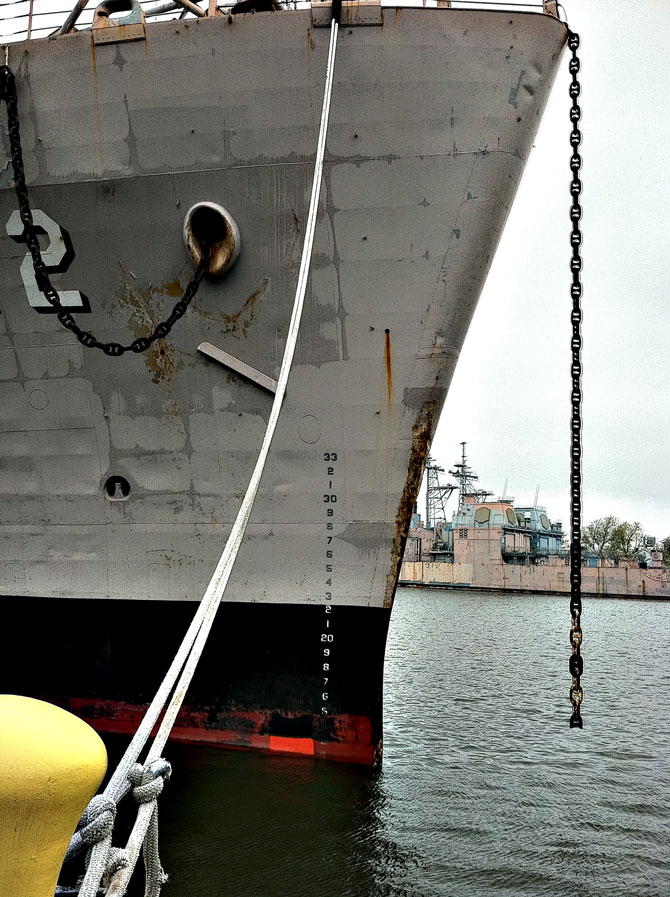
The chain at the bow has been broken, but this ship's not going anywhere. She's sitting high in the water because her engine has been removed, along with every scrap of salvageable anything in her hull. She's even lost her name and her commission.
Ships come here to the Philadelphia Navy Yard to surrender to the entropy at the far side of the military-industrial universe. After months of dismantlement, they're sold as scrap and towed across the river to New Jersey.
Philadelphia Navy Yard
ship
ruins
Sep 26, 2011
 The USS Ingraham tests its weapons during a recent live fire exercise at sea. Very soon, the 'ham will leave its home port of Everett, Washington, for a six-month deployment in the Pacific; the crew of about 200 enlisted men and women and a dozen or so officers includes Ensign Allen, aka Sparky, the ship's new electrical engineering officer.
The USS Ingraham tests its weapons during a recent live fire exercise at sea. Very soon, the 'ham will leave its home port of Everett, Washington, for a six-month deployment in the Pacific; the crew of about 200 enlisted men and women and a dozen or so officers includes Ensign Allen, aka Sparky, the ship's new electrical engineering officer.
Navy
Allen
USS Ingraham
ship
guns
Feb 13, 2012
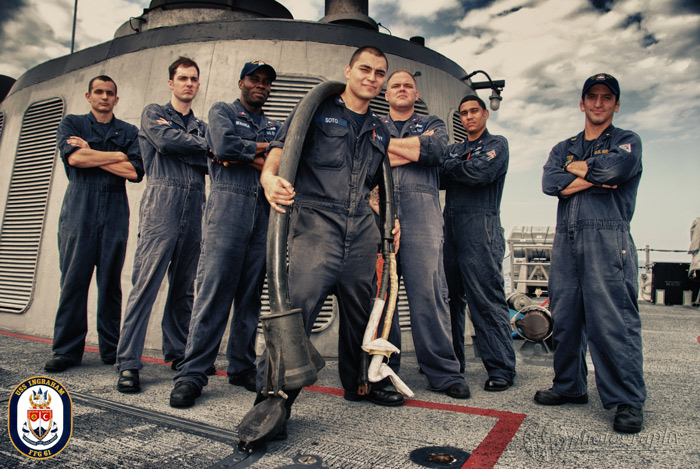 The electrical engineers of the navy frigate USS Ingraham pose for their official cruise portrait. From left to right: EM3 Huggins, EM3 Miller, EM1 Nkwanga, EM3 Acostasoto, EM1 Gillespy, EM2 Genaovargas, Ensign Stein.
The electrical engineers of the navy frigate USS Ingraham pose for their official cruise portrait. From left to right: EM3 Huggins, EM3 Miller, EM1 Nkwanga, EM3 Acostasoto, EM1 Gillespy, EM2 Genaovargas, Ensign Stein.
The Ingraham left its homeport of Everett, Washington, last September for a six-month deployment with an international force trying to suppress drug trafficking in the waters off Central and South America.
The thing around Acostasoto's neck is an electrical shore power cable.
Navy
work
USS Ingraham
ship
Aug 4, 2012
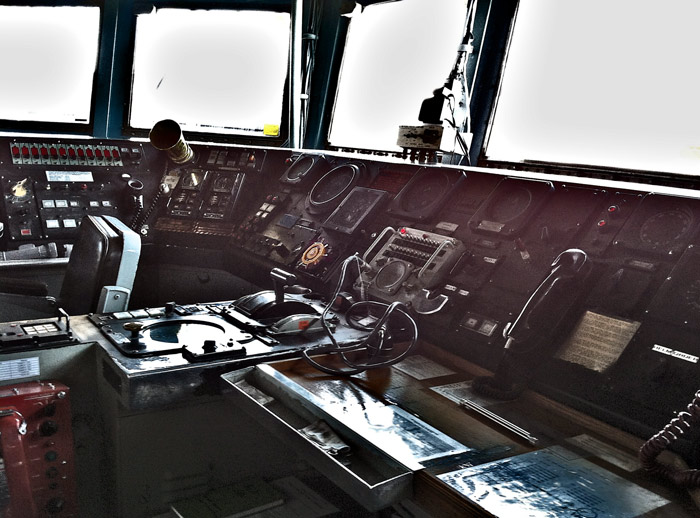 On the bridge of the navy frigate USS Ingraham, the tiny gold-colored wheel near the center of the picture, with spokes protruding from the rim, is what actually steers the ship. As the instrumentation suggests, American naval frigates were designed in the 1970s, back when phones were attached to the wall by curly cords. Frigates are gradually being decommissioned--sold off to countries looking for cheap warships--but meanwhile they are still very much in active service, accompanying aircraft carriers around the world or sailing independently on anti-piracy or anti-smuggling missions.
On the bridge of the navy frigate USS Ingraham, the tiny gold-colored wheel near the center of the picture, with spokes protruding from the rim, is what actually steers the ship. As the instrumentation suggests, American naval frigates were designed in the 1970s, back when phones were attached to the wall by curly cords. Frigates are gradually being decommissioned--sold off to countries looking for cheap warships--but meanwhile they are still very much in active service, accompanying aircraft carriers around the world or sailing independently on anti-piracy or anti-smuggling missions.
The Ingraham recently returned from a six-month deployment in the eastern Pacific near Panama, where its helicopters chased down small boats thought to be smuggling drugs to North America. The picture below shows family and friends standing on the flight deck during a recent tour of the ship conducted by Ensign Al, the Ingraham's electrical engineer who also serves as public information officer. Two helicopters operate from the flight deck. The ship in the background is a destroyer, slightly bigger than a frigate, which is also based at Naval Station Everett on Puget Sound north of Seattle.
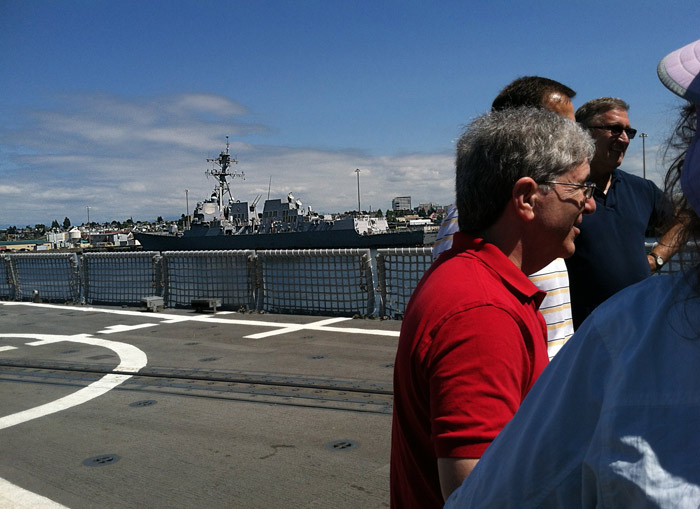
Navy
Allen
bridge
USS Ingraham
ship
Uncle Rich
wheel
warship
frigate
Aug 10, 2012
 At the feet of the fiddler in this picture is his open violin case, with a hat in it. He is riding the Washington State ferry that crosses Puget Sound between Edmonds and Kingston, just north of Seattle. I don't know if he's trying to make a living this way or just hoping to pull in a few bucks or simply earning back his ferry fare as he rides the water. It's also possible that he's doing this because he lost a bet. Whatever, this crossing had a soundtrack that I used to believe was better suited to trains than to boats: Foggy Mountain Breakdown and Orange Blossom Special.
At the feet of the fiddler in this picture is his open violin case, with a hat in it. He is riding the Washington State ferry that crosses Puget Sound between Edmonds and Kingston, just north of Seattle. I don't know if he's trying to make a living this way or just hoping to pull in a few bucks or simply earning back his ferry fare as he rides the water. It's also possible that he's doing this because he lost a bet. Whatever, this crossing had a soundtrack that I used to believe was better suited to trains than to boats: Foggy Mountain Breakdown and Orange Blossom Special.
(Reposted from a 7 November 2008 posting to an antediluvian ancestor of this blog.)
Washington
music
Puget Sound
ship
ferry
bluegrass
fiddle
train songs
Jan 29, 2013
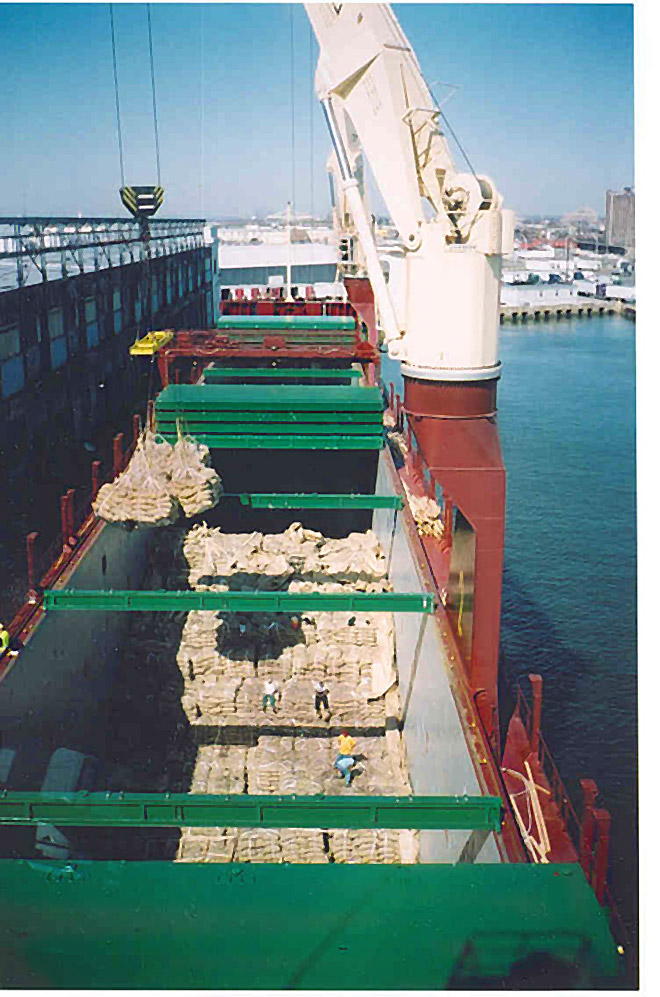
Almost half of all the cocoa beans that come to America–shipped from cocoa farms mostly in Ivory Coast and other West African places–sail up the Delaware River to the Port of Philadelphia and nearby ports. In Philly, the cocoa-bean facility is at Pier 84, where a warehouse about as long as three football fields is dedicated to cocoa handling and storage.
The beans show up here in burlap-type sacks, which have to be manhandled out of the hulls of cargo ships and onto the warehouse pallets. There are cranes and forklifts, of course, but it's still the kind of job for which an awful lot of the hardest work has to be done by hard workers.
Why is Philadelphia the port of entry for so many beans? Because Pennsylvanians make chocolate out of them, at factories all over the state, including a Godiva plant in Reading and a Hershey's operation in some town near Harrisburg with an amusement park. . . .
port
Philadelphia
work
ship
chocolate
cocoa beans
Port of Philadelphia
Nov 21, 2013
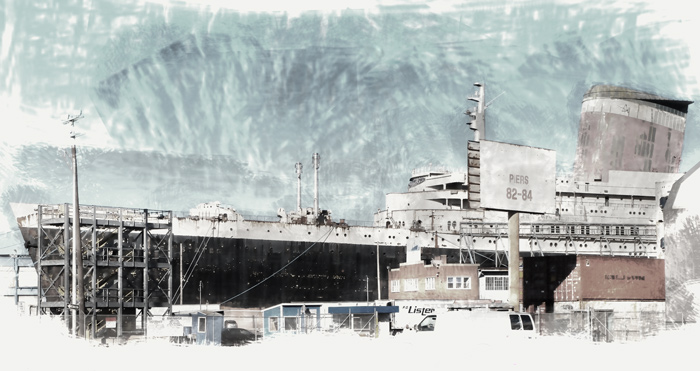 Down at the far edge of South Philly, in the land of the Big Box Stores, floats the biggest box of them all, the old SS United States.
Down at the far edge of South Philly, in the land of the Big Box Stores, floats the biggest box of them all, the old SS United States.
She was the biggest and most luxurious ocean liner ever built, more than 100 feet longer than the Titanic. There is more aluminum in her hull than in anything else on the planet. When she traversed the locks in the Panama Canal, there was just two feet of clearance on either side.
On her maiden voyage in 1952, she shattered the trans-Atlantic speed records in both directions. But 1952 was near the wrong end of the era of gilded passenger liners, and the SS United States has now spent more than half her life quietly rusting away at pierside in Philadelphia, across the street from an Ikea store that could probably fit comfortably in her ballroom.
That's an exaggeration. Most likely, her ballroom could only hold Best Buy.
ship
South Philly
waterfront
Delaware River
rust
SS United States
(Image credit: Little Fuji)
Apr 26, 2014
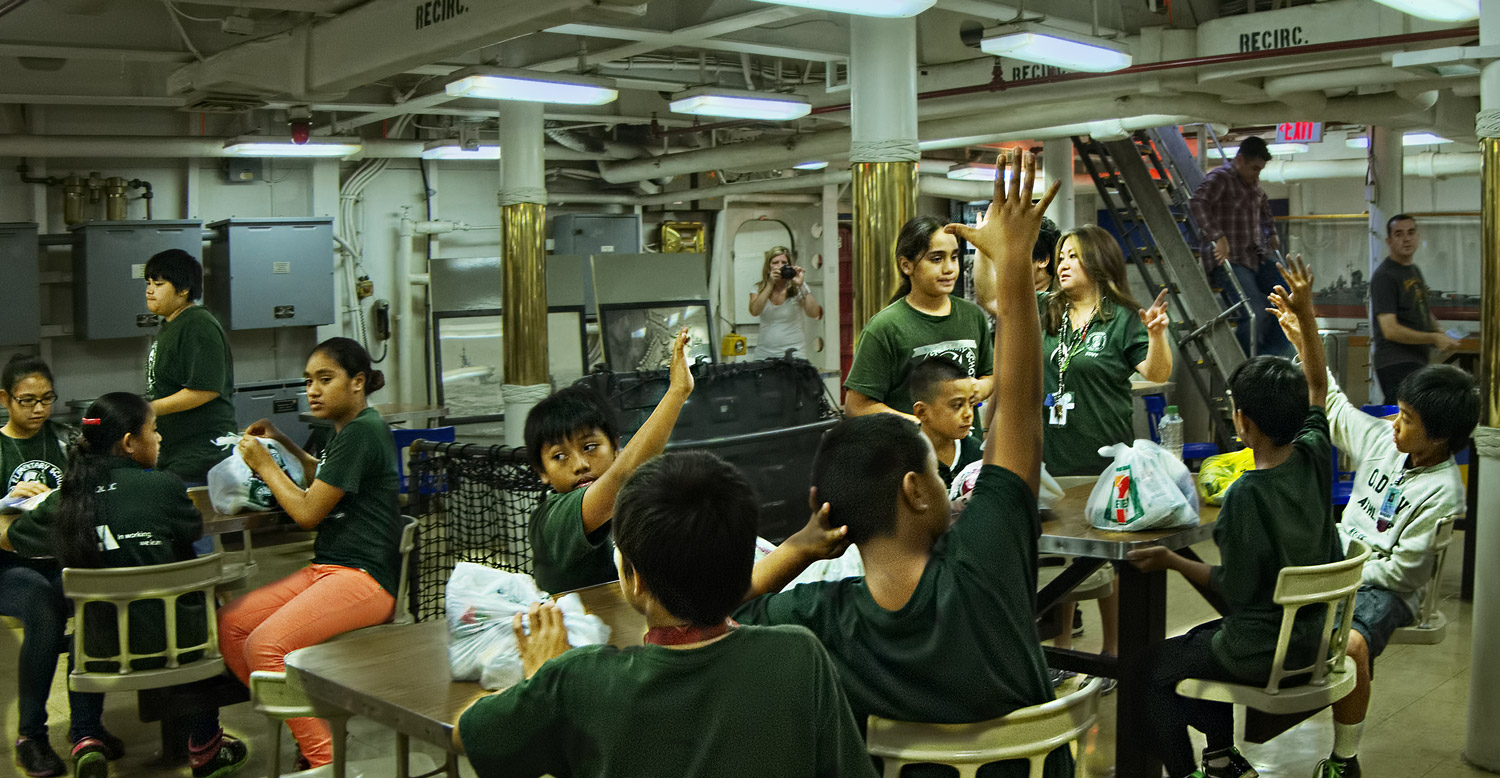 Some of the middle school students participating in their class field trip to the battleship USS Missouri in Pearl Harbor, Hawaii, appear enthusiastically prepared to answer their teacher's question. Of course the question might be: Who's ready for lunch?
Some of the middle school students participating in their class field trip to the battleship USS Missouri in Pearl Harbor, Hawaii, appear enthusiastically prepared to answer their teacher's question. Of course the question might be: Who's ready for lunch?
The students are seated in one of several mess halls deep in the ship; several ladders above them is the deck where the Japanese surrendered on September 2, 1945, to Gen. Douglas MacArthur and representatives of all the Allied powers, finally ending World War II. The American flag flown that day at the ceremony had only 31 stars and was hung backwards, stars at upper right; it was the original flag brought to Tokyo by Admiral Perry in 1853 when Japan was first opened to international trade, and it had frayed so badly over the years that one side of it–the right side–was sewed over with a protective linen covering, leaving only the reverse side for display.
Just below the deck where the ceremony took place is a dented spot in the hull. Six months before the surrender, during the bombardment of Okinawa, a kamikaze pilot had crashed into the Missouri, losing a wing off his plane and starting a gasoline fire aboard ship. The fire was quickly put out, and the ship was only dinged, not seriously damaged; the pilot, however, did not survive. The story is that the Missouri's captain, William Callaghan, had to rescue the pilot's corpse from sailors attempting to summarily dispose of it; Captain Callahan insisted on a full funeral service for the pilot, with military honors and burial at sea. The dent in the hull was never repaired.
After World War II, President Truman decommissioned every other battleship in the navy but insisted on maintaining the Missouri in active service, over the objections of military advisors. Battleships had no role to play in postwar navy planning. The Missouri was sent to Korea, however, during that conflict. It was then mothballed–but returned to duty one last time in 1984 during President Reagan's military buildup. It provided artillery support during the First Gulf War before being finally deactivated.
Since 1998, the Missouri has been a major tourist attraction at Pearl Harbor, as well as a school field trip destination. And there's plenty on board for the schoolchildren to see: big guns, tall stacks of bunks, signs insisting on short showers while at sea, and, of course, the backwards flag and the dent in the hull.
Up top, on deck underneath some of those big guns, a few members of the Marine Band entertained the tourists. The day we and the middle schoolers visited, the band played "Jingle Bell Rock," but now that it's springtime, the setlist has probably changed.
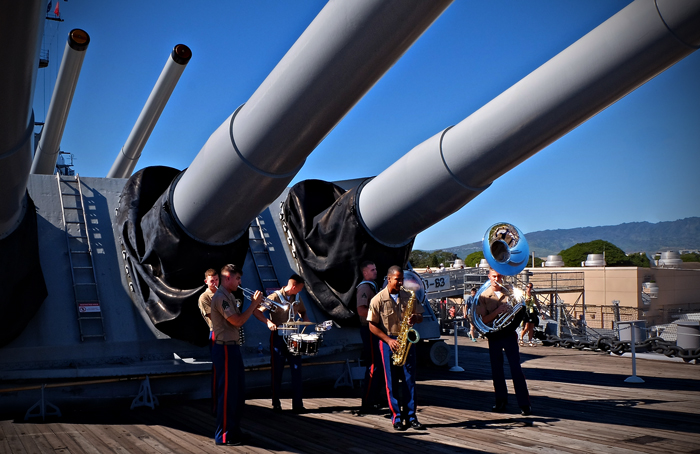
middle school
children
World War II
ship
field trip
USS Missouri
Pearl Harbor
Hawaii
(Image credit: Little Fuji)
May 8, 2014
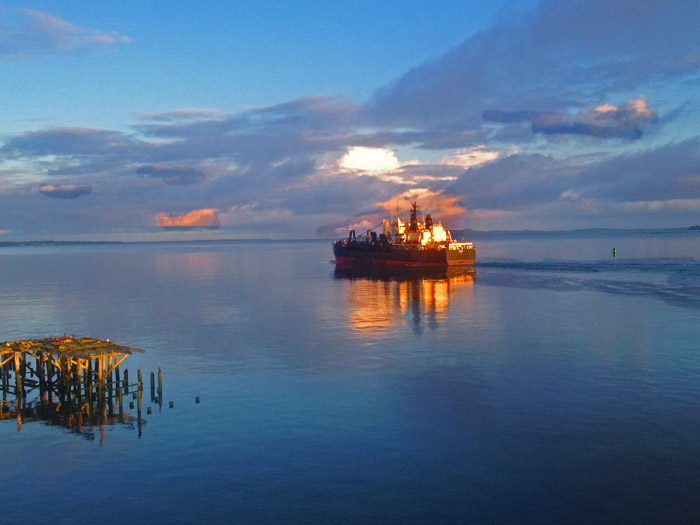 On November 15, 1805, Lewis and Clark first saw the Pacific Ocean here, at the mouth of the Columbia River. It was raining. The expedition hunkered down across from a headland that English sailors had already named Cape Disappointment; it rained on them that day and the next day and the day after that, and all but twelve of the succeeding days for five months straight.
On November 15, 1805, Lewis and Clark first saw the Pacific Ocean here, at the mouth of the Columbia River. It was raining. The expedition hunkered down across from a headland that English sailors had already named Cape Disappointment; it rained on them that day and the next day and the day after that, and all but twelve of the succeeding days for five months straight.
In May, however, as this photo proves, disappointment is no part of the scene.
We head westward this morning for another of Lewis and Clark's campsites: Missoula, Montana, which they called Traveller's Rest.
These here Good Mornings are unlikely until late in the month.
sunset
Oregon
ship
Pacific Ocean
Columbia River
(Image credit: Kathy Bellenger)
Nov 17, 2014
 The dome and minarets of Istanbul's Ottoman-era Ortakoy Mosque flank the bridge towers at the European end of Turkey's Bosphorus Bridge; to the right is the superstructure of a ship passing through the strait.
The dome and minarets of Istanbul's Ottoman-era Ortakoy Mosque flank the bridge towers at the European end of Turkey's Bosphorus Bridge; to the right is the superstructure of a ship passing through the strait.
landscape
Turkey
waterscape
bridge
ship
towers
Istanbul
Bosphorus
mosque
(Image credit: K. Maldre)
Feb 20, 2015
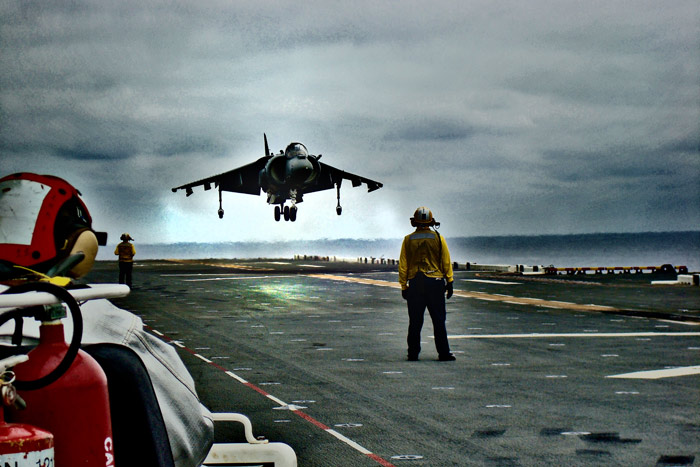 Somewhere in the eastern Pacific, a Harrier jump jet prepares to drop down onto the deck of the USS Bonhomme Richard.
Somewhere in the eastern Pacific, a Harrier jump jet prepares to drop down onto the deck of the USS Bonhomme Richard.
Navy
work
ship
Pacific
Harrier
landing
USS Bonhomme Richard
jet
(Image credit: Allen Stein)
Apr 2, 2016
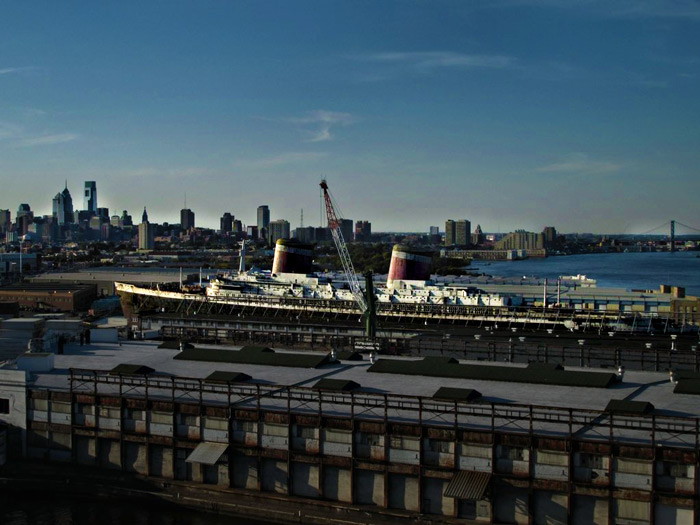 Twenty years ago, the SS United States was tied up to a wharf on the Delaware River in South Philadelphia to rust away next to Home Depot and Ikea and the cars whizzing by on Columbus Boulevard. The plan was to eventually ???
Twenty years ago, the SS United States was tied up to a wharf on the Delaware River in South Philadelphia to rust away next to Home Depot and Ikea and the cars whizzing by on Columbus Boulevard. The plan was to eventually ???
Once upon a time, this was the largest and fastest ocean liner on earth. Building it was the forty-year obsession of a man who never spent a day in school studying ship design; William Francis Gibbs was a lawyer by training, but in 1913, a year after that thing happened with the Titanic, he left his law practice and started drawing sketches for a bigger, better, safer, faster passenger ship.
The ship is 980 feet long, more than 100 feet longer than the Titanic. It's divided into 20 watertight compartments reaching almost fifty feet above the waterline, and it's designed to keep on sailing even if as many as five of the compartments are breached and flooded. It's also virtually fireproof; the only wood on board was in a Steinway grand piano.
When the SS United States was finally constructed after World War II, certain of its design features, including its four propellers and the shape of its hull underwater, were classified military secrets, in case the ship were ever refitted as a troop transport. Its maiden voyage from New York to Rotterdam–during which its engines ran at about about two-thirds of full speed–took less than four days, setting an Atlantic crossing speed record that was only broken by subsequent SS United States crossings. To this day, no other ocean liner has ever been built that could sail any faster.
But air travel, of course, waits for no ship. In 1969, the SS United States sailed for the last time under its own power. After idling for a while in New York, it was towed to Ukraine, where it was stripped of all its fittings (and of the asbestos that had helped make it so fire-resistant). Eventually, it was tied up a pier in Philadelphia, designer Gibbs's hometown, where business plan after business plan for the hulking hull never could attract the hundreds of millions of dollars that would be necessary just to stop the rust and turn it into something commercial, perhaps a floating hotel that would never leave the pier.
A nonprofit conservancy organization, meanwhile, has had to raise $60,000 a month just to keep the rusted thing afloat. This year is the final deadline, they say; if the money for a real plan doesn't show up this year, the ship will finally have to be scrapped.
At the moment, there's a new plan: Crystal Cruises, a Hong Kong–based cruise line, has taken over the monthly maintenance costs and signed an option to buy the ship within a year. The company says it is currently studying the feasibility of restoring it as a luxury cruise vessel, which could cost something like $700 million.
So maybe she'll sail again. Meanwhile, you can get a really good view of what's left of the SS United States from the parking lot outside Longhorn Steak House.
Philadelphia
ship
Delaware River
SS United States
William Francis Gibbs
big box stores
wharves
ocean liner
decay
(Image credit:
Mar 17, 2017
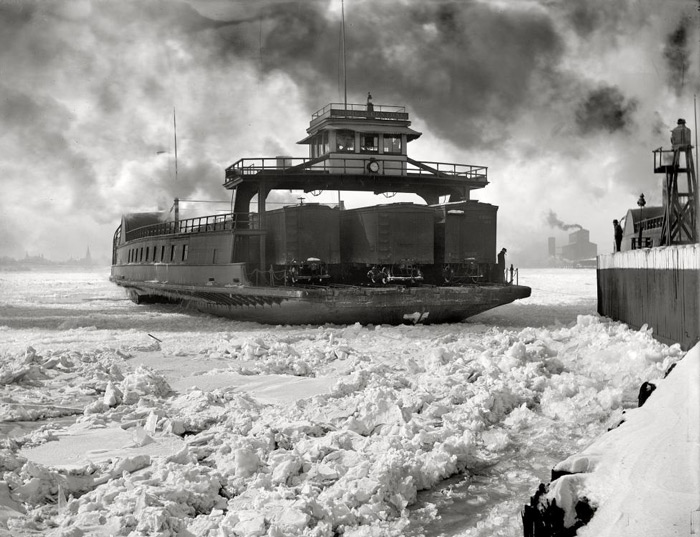 The ferry boat Michigan Central, carrying railroad cars, prepares to enter its slip on the Detroit River, circa 1900.
The ferry boat Michigan Central, carrying railroad cars, prepares to enter its slip on the Detroit River, circa 1900.
Detroit
winter
ice
ship
1900
ferry
(Image credit: Detroit Publishing Co via Shorpy)

 The USS Ingraham tests its weapons during a recent live fire exercise at sea. Very soon, the 'ham will leave its home port of Everett, Washington, for a six-month deployment in the Pacific; the crew of about 200 enlisted men and women and a dozen or so officers includes Ensign Allen, aka Sparky, the ship's new electrical engineering officer.
The USS Ingraham tests its weapons during a recent live fire exercise at sea. Very soon, the 'ham will leave its home port of Everett, Washington, for a six-month deployment in the Pacific; the crew of about 200 enlisted men and women and a dozen or so officers includes Ensign Allen, aka Sparky, the ship's new electrical engineering officer.


 At the feet of the fiddler in this picture is his open violin case, with a hat in it. He is riding the Washington State ferry that crosses Puget Sound between Edmonds and Kingston, just north of Seattle. I don't know if he's trying to make a living this way or just hoping to pull in a few bucks or simply earning back his ferry fare as he rides the water. It's also possible that he's doing this because he lost a bet. Whatever, this crossing had a soundtrack that I used to believe was better suited to trains than to boats: Foggy Mountain Breakdown and Orange Blossom Special.
At the feet of the fiddler in this picture is his open violin case, with a hat in it. He is riding the Washington State ferry that crosses Puget Sound between Edmonds and Kingston, just north of Seattle. I don't know if he's trying to make a living this way or just hoping to pull in a few bucks or simply earning back his ferry fare as he rides the water. It's also possible that he's doing this because he lost a bet. Whatever, this crossing had a soundtrack that I used to believe was better suited to trains than to boats: Foggy Mountain Breakdown and Orange Blossom Special.







